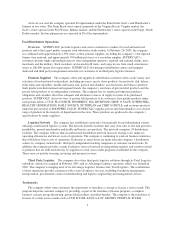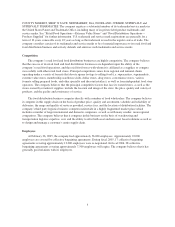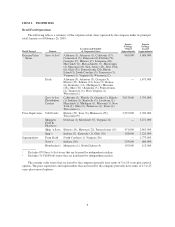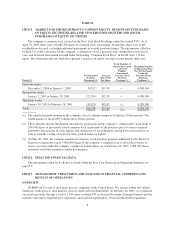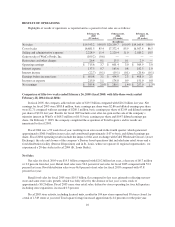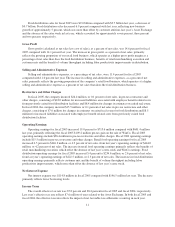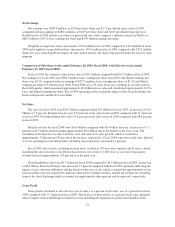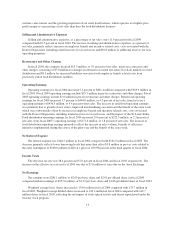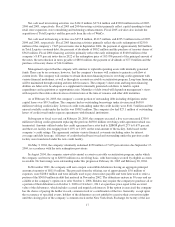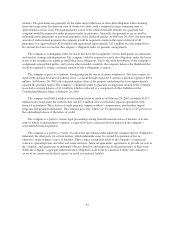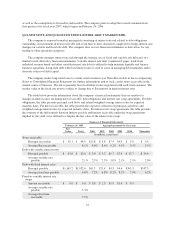Albertsons 2005 Annual Report Download - page 20
Download and view the complete annual report
Please find page 20 of the 2005 Albertsons annual report below. You can navigate through the pages in the report by either clicking on the pages listed below, or by using the keyword search tool below to find specific information within the annual report.
RESTRUCTURE AND OTHER CHARGES
In fiscal 2000, 2001, and 2002, the company commenced restructuring programs designed to reduce costs
and enhance efficiencies and included facility consolidation and disposal of non-core assets and assets not
meeting return objectives or providing long-term strategic opportunities. The restructuring plans resulted in the
company recording pre-tax restructure and other charges in fiscal 2000, 2001 and 2002.
In fiscal 2003, all activity for the fiscal 2002, 2001 and 2000 restructure plans was completed. The table
below shows the remaining restructure reserves for the 2002, 2001, and 2000 plans as of February 26, 2005, as
well as reserve related activity for the three fiscal years then ended.
Restructure
Plan
Fiscal 2002
Reserve
Balance
Fiscal 2003
Activity Fiscal 2003
Reserve
Balance
Fiscal 2004
Activity Fiscal 2004
Reserve
Balance
Fiscal 2005
Activity Fiscal 2005
Reserve
BalanceUsage Adjustment Usage Adjustment Usage Adjustment
(In millions)
2002 $16.3 $ (9.3) $ (3.6) $ 3.4 $ (3.8) $ 0.6 $ 0.2 $(0.2) $ — $ 0.0
2001 $56.0 $(35.5) $11.7 $32.2 $(17.3) $11.7 $26.6 $(6.6) $22.3 $42.3
2000 $18.0 $ (9.8) $ 2.9 $11.1 $ (9.1) $ 0.5 $ 2.5 $(1.4) $ — $ 1.1
The company recognized pre-tax restructure and other charges of $26.4 million, $15.5 million and $2.9
million for fiscal years 2005, 2004, and 2003 respectively. These charges reflect changes in liabilities associated
with employee benefit related costs from previously exited distribution facilities as well as changes in estimates
on exited real estate, including asset impairment. Fiscal 2005 charges related primarily to restructure 2001 and
consisted of reserve adjustments of $22.3 million, asset impairment charges of $0.5 million, and property holding
costs of $3.6 million. Fiscal 2004 charges reflect the net adjustments to the restructure reserves of $12.8 million,
as well as asset impairment adjustments of $2.7 million for restructure 2001. Fiscal 2003 charges reflect the net
adjustments to the restructure reserves of $11.0 million, as well as asset impairment adjustments of $(3.6) million
and $(4.5) million for restructure 2001 and 2000, respectively.
The remaining 2001 restructure reserves includes $25.9 million for employee benefit related costs and $16.4
million for lease related costs for exited properties. In fiscal 2005, there was an increase in 2001 restructure reserves
of $22.3 million for employee benefit related costs for multiemployer plan liabilities resulting from withdrawal
notices received in fiscal 2005 for previously exited distribution facilities and changes in estimates on exited real
estate of $18.0 million and $4.3 million, respectively.
CRITICAL ACCOUNTING POLICIES
The preparation of consolidated financial statements in conformity with accounting principles generally
accepted in the United States of America requires management to make estimates and assumptions that affect the
reported amounts of assets and liabilities and disclosure of contingent assets and liabilities at the date of the
financial statements and the reported amounts of revenues and expenses during the reporting period. Actual
results could differ from those estimates.
Significant accounting policies are discussed in the Summary of Significant Accounting Policies in the
accompanying Notes to Consolidated Financial Statements. Management believes the following critical
accounting policies reflect its more subjective or complex judgments and estimates used in the preparation of the
company’s consolidated financial statements.
Allowances for Losses on Receivables
Management makes estimates of the uncollectibility of its accounts and notes receivable portfolios. In
determining the adequacy of the allowances, management analyzes the value of the collateral, customer financial
14


